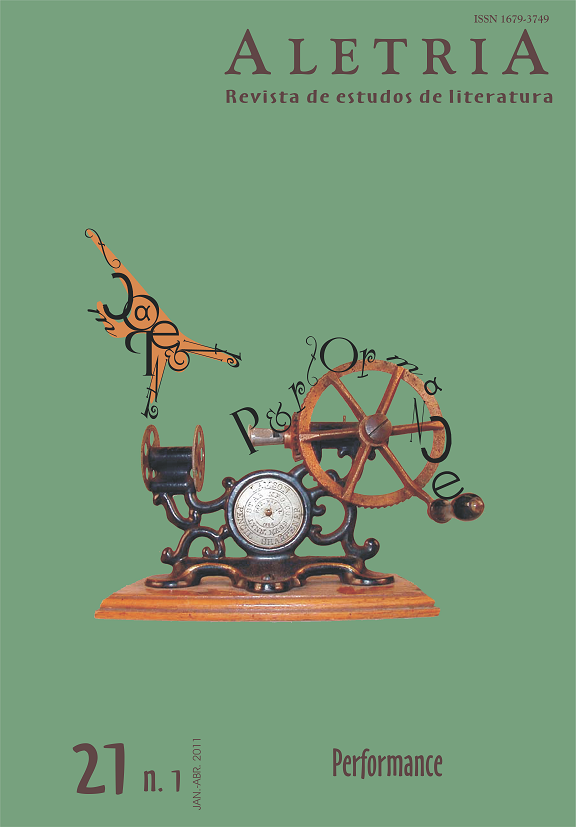Batucar-cantar-dançar: desenho das performances africanas no Brasil
DOI:
https://doi.org/10.17851/2317-2096.21.1.133-146Palavras-chave:
performance, performance afro-brasileira, tradição africanaResumo
A partir do poderoso trio “batucar-cantar-dançar”, encontrado como característica principal da performance na África negra pelo filósofo do Congo Bunseki Fu-Kiau, o autor analisa os processos da recriação em solo brasileiro das principais performances afro-brasileiras, tanto religiosas como seculares.
Downloads
Referências
Agassiz, Louis. A journey in Brazil. Boston: Ticknor and Field, l868.
ALVARENGA, Oneyda. Música popular brasileira. Rio de Janeiro: Globo, 1949.
ASCHENGREEN, Erick. The beautiful danger: facets of romantic ballet. Dance Perspective 58, Summer 1974.
BASTIDE, Roger. The African religions of Brazil: toward a sociology of the interpretation of civilizations. Baltimore: Johns Hopkins University Press, l978.
BAUMANN, Hermann (Chefe da Expedição a Angola) FILMES: Tanze der Tschokwe (1937) (MGZHB, 4-507) e Tanze der Frischberschnitteen (1937) (MGZHB, 2-506) l930, The New York Public Library for the Performing Arts, Lincoln Center, N. York.
BRAGA, Greenhalgh H. Faria. De Vassouras: história, fotos, gente. “Instruções para a comissão permanente nomeada pelos fazendeiros do município de Vassouras”, Rio de Janeiro: Ultra-set Edi., 1978.
FREYRE, Gilberto. Sociologia: introdução ao estudo dos seus princípios. Rio de Janeiro: José Olympio, 1945.
FREYRESS, George Hilhlm (1815). Viagem ao Interior do Brasil. São Paulo: USP, 1982.
FU-KIAU, Bunseki K. K. Bulwa meso, master’s voice of Africa. v. I, inédito.
LOMAX, Alan; BARTENIEFF, Irmgard; PAULAY, Forrestine. Choreometrics profiles. In: LOMAX, Alan (Ed.). Folksong Style and Culture. Washington, D. C.: American Association for the Advancement of Science, 1968.
LIGIÉRO, Zeca; DANDARA. Umbanda: paz, liberdade e cura. Rio de Janeiro: Record, 1998.
LIGIÉRO, Zeca. Candomblé is art-life-religion. In: GALEMBO, Phillis. Divine inspiration from Benin to Bahia. Albuquerque: University of New Mexico Press, 1993.
LIGIERO, Zeca. The celebration of Iemanjá, New Year’s Eve in Rio de Janeiro: tradition, negociation and the transformation of an African Goddess. In: GÁLVEZ, Alyshia. Performing religion in the Américas: media, politics and devotional practices of the twenty-first century. London; New York; Calcutá: Seagull Books, 2008.
LIGIERO, Zeca. Direção do Vídeo Samba no Pé, 1993-2008. Produção NEPAA/UNIRIO.
LOMAX, Alan (Ed.). Folk song style and culture. Washington D.C.: America Association for the Advancement of Science, l968.
MALONE, Jacqui. Steppin’ on the blues: the visible rhythms of African American dance. Urbana and Chicago: University of Illinois Press, l996.
REGO, José Carlos. Dança do samba: exercício do prazer. Rio de Janeiro: Aldeia, Sindicato Nacional dos Editores de Livros, l994.
RODRIGUES, Ana Maria. Samba negro, espoliação branca. São Paulo: Hucitec, l984.
RUGENDAS, Johann Moritz. Rugendas brasiliana da Biblioteca Nacional. Rio de Janeiro, 2001.
SPIX J. B. von; MARTIUS, C. F. P. von SPIX, Viagem pelo Brasil. Rio de Janeiro: Biblioteca Municipal Mário de Andrade, 2001.
Downloads
Publicado
Edição
Seção
Licença
Copyright (c) 2011 Zeca Ligiéro (Autor)

Este trabalho está licenciado sob uma licença Creative Commons Attribution 4.0 International License.
Autores que publicam nesta revista concordam com os seguintes termos:Autores mantém os direitos autorais e concedem à revista o direito de primeira publicação, com o trabalho simultaneamente licenciado sob a Licença Creative Commons Attribution que permite o compartilhamento do trabalho com reconhecimento da autoria e publicação inicial nesta revista.Autores têm autorização para assumir contratos adicionais separadamente, para distribuição não-exclusiva da versão do trabalho publicada nesta revista (ex.: publicar em repositório institucional ou como capítulo de livro), com reconhecimento de autoria e publicação inicial nesta revista.Autores têm permissão e são estimulados a publicar e distribuir seu trabalho online (ex.: em repositórios institucionais ou na sua página pessoal) a qualquer ponto antes ou durante o processo editorial, já que isso pode gerar alterações produtivas, bem como aumentar o impacto e a citação do trabalho publicado (Veja The Effect of Open Access).














